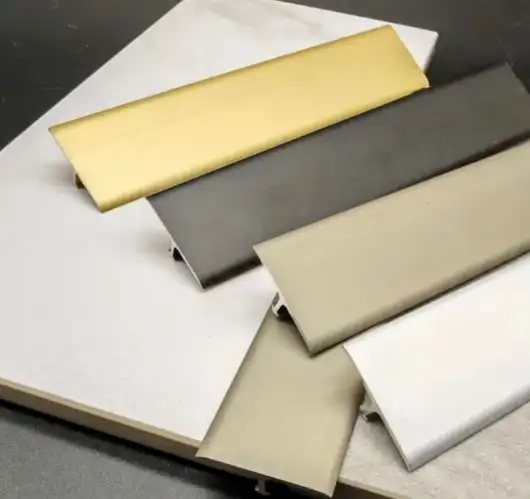
What Are the Key Differences Between Aluminum and Plastic T-Moulding?
Choosing T-moulding for floor or panel joins means knowing the basic differences between aluminum and plastic is very important. Aluminum gives better strength and keeps its shape well. Plastic gives flexibility and saves money. This part looks at what they are made of, how they look, and how they work in different places to help you choose well.
Material Composition and Structural Properties
Aluminum T-moulding comes from pressed aluminum mixes. These are known for being strong, stiff, and resisting rust. Plastic T-moulding is usually made from PVC or polyethylene. These bend more easily but are less strong. Aluminum injection molds handle heat better and hold their shape well. This makes them perfect for very exact jobs. This strength difference changes how each material holds up under pressure and over years.
Visual Appearance and Aesthetic Options
Aluminum mouldings often have special finishes like anodized, brushed, or powder-coated. They give a modern metal look that fits well with new design ideas. Plastic mouldings come in more colors. However, they often look less expensive because of their dull or shiny plastic surfaces. For jobs where looks matter a lot, like high-end stores, aluminum gives a more upscale feel.
Performance in High-Traffic or Industrial Environments
Aluminum resists squashing and bending better. This makes it more suitable for places with many people walking or for factory use. Plastic can bend or break under the same conditions. The natural strength of aluminum molds allows quicker production times and bigger amounts. This means it works better for longer in tough spots.
LanHe knows customers need clear answers on which material gives better strength and lasting worth. This is especially true when both lasting power and design are very important.
How Does Durability Compare Between Aluminum and Plastic T-Moulding?
How long it lasts is a key point in choosing between aluminum and plastic T-moulding. Aluminum does great in busy or factory places because it resists wear, knocks, and changing temperatures. Plastic might wear out faster under heavy use but stays a cheaper choice for light-use areas.
Resistance to Wear, Impact, and Deformation
Aluminum is very good at resisting wear from constant touching or hard knocks. Its metal surface doesn’t scratch or dent easily with normal use. Plastic mouldings resist small marks but are more likely to crack under heavy weights or sharp hits.
Longevity in Commercial and Residential Applications
In business spots like airports or shopping centers, aluminum T-moulding can last many years without wearing much. Plastic choices might need changing every few years, depending on how many people walk on them and sunlight exposure. Aluminum molds also last longer than other substances.
Behavior Under Temperature Fluctuations
Plastic grows and shrinks a lot when temperatures change. This can cause it to become loose or bend over time. Aluminum stays the same shape across a wide range of hot and cold. This makes it great for both inside and outside fitting.
LanHe understands customers want to know their money spent will hold up against weather and use without needing lots of fixes or new parts.
Is There a Cost Difference Between Aluminum and Plastic T-Moulding?

Plastic T-moulding costs less at first. However, aluminum gives good value over time with little care and few replacements needed. This part explains starting costs versus long-term spending. It helps you find the best money-saving answer for your job.
Initial Purchase Cost Comparison
Plastic T-moulding usually costs less upfront. This is because the stuff it’s made from is cheaper and it’s easier to make. Aluminum has a higher starting price. This is due to the cost of the raw stuff and the trickier making steps.
Long-Term Value and Maintenance Considerations
Aluminum needs more money at the start. But its longer life means you don’t need to replace it often. While aluminum molds might cost more initially, they save money over time by needing less care. Plastic might cost you again and again because you need to replace worn parts.
LanHe helps people balance short-term money limits with long-term payback by giving custom solutions based on total cost over the life of the product.
What Are the Environmental Impacts of Each Material?
Being earth-friendly is more and more vital in building and design. Aluminum is 100% recyclable and saves energy when reused. Plastic is hard to recycle. Here, we compare their effects on nature to help make green choices.
Recyclability of Aluminum vs. Plastic
Aluminum is 100% recyclable without losing quality. This is a big plus for projects caring about the planet. Most plastics can be recycled but often end up buried because they are dirty or lack recycling plants.
Energy Consumption During Manufacturing
Making new aluminum needs a lot of power. However, recycled aluminum uses just 5% of that energy. Plastic making generally uses less energy at first but doesn’t have the good recycling circle that aluminum has.
Lifecycle Sustainability Analysis
Choosing aluminum molds fits well with earth-friendly making habits. Over its whole life, aluminum leaves a smaller mark on nature when recycling is included.
LanHe backs green building efforts by providing recyclable shapes that match LEED rules and sustainable design aims.
How Easy Are Aluminum and Plastic T-Mouldings to Install?
How hard they are to put in changes between materials. Plastic is good for doing it yourself. Aluminum needs special tools for exact cuts. This part looks at bending, fitting different surfaces, and work needed to guide your putting-in method.
Installation Methods for Each Material Type
Plastic mouldings can be cut easily with hand tools like knives or shears. This makes them good for quick do-it-yourself jobs. Aluminum needs special tools like miter saws with strong blades. But it gives neater cuts with perfect angles.
Flexibility and Adaptability to Various Surfaces
Plastic bends. This lets it fit curved surfaces more easily than stiff aluminum shapes. But this same bendiness can make it not line up well over time. Aluminum gives steady straight lines. These are perfect for pro-level finishes on flat surfaces.
LanHe helps fitters by offering ready-drilled choices and custom lengths. This reduces hard work during setup.
In Which Situations Is One Material More Suitable Than the Other?
Picking between aluminum and plastic depends on what the job needs. Business areas gain from aluminum’s lasting power. Home jobs might prefer plastic for saving money. We look at best uses based on people traffic, looks, and safety rules.
Commercial vs. Residential Applications
In busy business spots like hotels or shopping malls, aluminum’s long life makes its higher cost okay. For home uses with few people and tight money, plastic might work if looks aren’t the main worry.
Aesthetic Requirements in Interior Design Projects
Designers wanting neat lines with shiny finishes often choose aluminum mouldings for modern insides. For fun themes needing bright colors or soft edges, plastic might offer more choices at lower cost.
Safety Considerations in Public Spaces
Aluminum resists fire better. This gives it an edge over plastic for public safety rules. Plastic might let out bad smoke if burned. This is a key point in hospitals or schools.
LanHe helps choosers pick the right part based on job needs like safety codes, design ideas, or money limits.
Why Choose Shandong Lanhe Import and Export Co., Ltd. for Your T-Moulding Needs?

LanHe stands out with top-quality making, worldwide supply, and custom answers. Whether you need best aluminum shapes or money-saving plastic mouldings, our know-how gives reliable work and design choices.
Overview of Product Quality and Manufacturing Standards
Shandong Lanhe Import & Export Co., Ltd follows international quality rules very strictly all through its shaping steps. This is from picking the raw stuff to the final check. It makes sure each shape meets tough work standards.
Commitment to Customer Service and Global Distribution
With a skilled export team serving people across Europe, North America, Southeast Asia, and more, LanHe gives not just parts but custom answers backed by quick help channels.
Range of Available Profiles, Finishes, and Customization Options
LanHe has a big choice of T-moulding shapes. This includes normal sizes and special designs. These come in finishes like anodized silver, champagne gold, and matte black. This ensures they fit many different job needs.
Summary of Key Comparisons Between Aluminum and Plastic T-Mouldings
Feature Aluminum Plastic
Strength High Moderate
Appearance Premium metallic Colorful but basic
Durability Long-lasting Prone to wear
Cost Higher upfront Lower initial
Sustainability Fully recyclable Limited recyclability
Installation Requires tools Easier DIY
Ideal Use Commercial/Industrial Residential/Light use
Frequently Asked Questions (FAQs)
What are the main advantages of aluminum T-moulding over plastic?
Aluminum injection molds handle heat well and keep their shape exactly. They are perfect where power, looks, long life, and being green matter most.
Can aluminum T-moulding be used outdoors?
Yes. Because it resists rust, especially when anodized, aluminum works well outside without rusting or wearing down over years.
Is plastic T-moulding easier to cut than aluminum?
Yes. Plastic can be cut using easy hand tools. Aluminum needs special saws for exact putting-in results. But it gives cleaner edges once fitted right.


